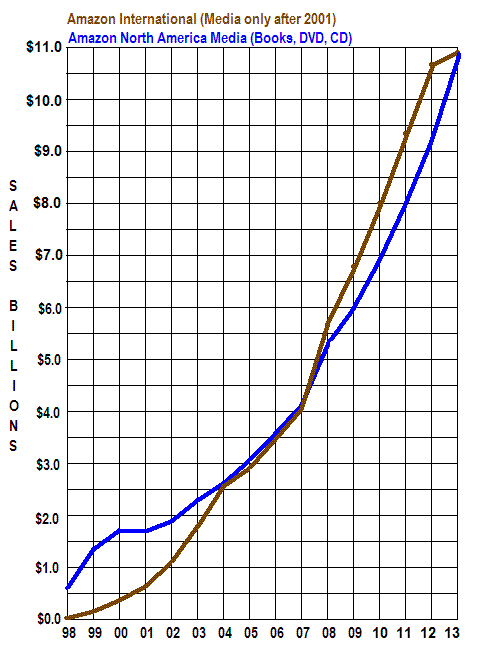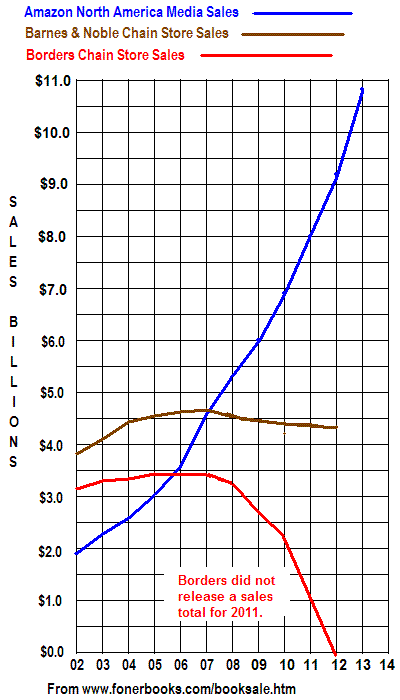
Amazon North America media sales (Books, DVDs, CDs) have soared passed the chain store sales. I don't include the BN.com total in the B&N number, which would still be lower as BN.com doesn't sell a half billion a year, because the point of the graph is to contrast online sales vs brick-and-mortar sales.

An interesting take away from Amazon's growing dominance of the retail book trade is how well the concept of a virtual bookstore has succeeded. The last numbers I saw indicated that the bookstore chain superstores, with 100,000 to 200,000 books in stock, turn their inventory around twice a year. A rough math check would be to take the approximately $4.5 billion sold by the B&N chain and divide by their 700+ superstores for revenue of under $6.5 million per store/year. Turning the inventory of each store twice a year would imply 200,000 to 400,000 books sold per year (I'm just ignoring CD's, coffee, smaller stores, etc), for an average sales price between $32.50 and $16.25 per item, depending on how many books the average store stocks. The actual numbers would be lower to make up for the factors I ignored. If they're turning the inventory more than twice a year, it can't be by much.
Bookstore chains supposedly follow a Pareto function, where something like 80% of their sales comes from 20% of the titles. Most of the titles in superstore chains are there as wallpaper, to make the cavernous building look like a bookstore, and the titles that don't sell eventually get returned to the publishers. Bookstore chains are heavily reliant on blockbusters to bring in customers, and to make that happen, sell them at steep discounts. Part of the 2008 drop in chain sales in no doubt due to the end of the Harry Potter series.
Around 2,000,000 titles at Amazon sell at least one copy a year. They do so without crowding other books off the shelves, and there are millions and millions more titles selling at an even slower pace. But what must drive B&N and Borders absolutely nuts is that the "superstore" portion of Amazon's inventory, the top 200,000 or so titles, are virtual as well. When the college bookstore season rolls around, tens of thousands of course titles pop into the top 200,000, without Amazon having to take any action to make room for them. When the students all have their books for the semester, the consumer and professional titles rush back in to fill their places. The same thing happens with summer reading books and holiday gift books. It's all automatic, and it simply adds to Amazon's sales. Whatever the top 200,000 titles are at any given time doesn't mean that those titles being outpaced for the week or the month are selling at a slower rate than they previously had on Amazon. It's simply means other titles are selling more at the moment. It's this virtual bookstore that's driven Amazon's supremacy, more and more sales, no limit to shelf space in the store.
No comments:
Post a Comment